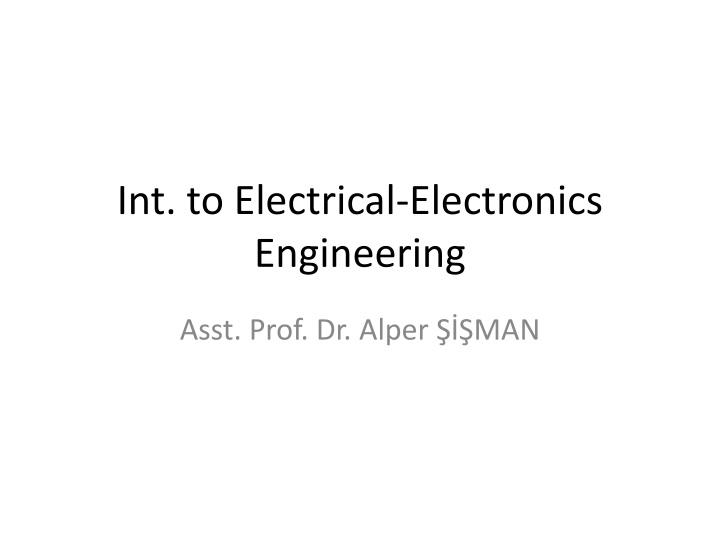
Electrical-Electronics Engineering Insights: Ohm's Law, Faraday's Law, Kirchhoff's Circuit Laws
Explore fundamental concepts in electrical-electronics engineering such as Ohm's Law, Faraday's Law of Induction, and Kirchhoff's Circuit Laws. Understand the principles behind potential, current, voltage, and electromagnetic induction with practical examples and diagrams.
Download Presentation

Please find below an Image/Link to download the presentation.
The content on the website is provided AS IS for your information and personal use only. It may not be sold, licensed, or shared on other websites without obtaining consent from the author. If you encounter any issues during the download, it is possible that the publisher has removed the file from their server.
You are allowed to download the files provided on this website for personal or commercial use, subject to the condition that they are used lawfully. All files are the property of their respective owners.
The content on the website is provided AS IS for your information and personal use only. It may not be sold, licensed, or shared on other websites without obtaining consent from the author.
E N D
Presentation Transcript
Int. to Electrical-Electronics Engineering Asst. Prof. Dr. Alper MAN
Ohms Law What is potential? The potantial of a point is defined : as the required energy to bring the unity charge from infinity to that point in an electric field. dW=F*dr=> dW = qEdr, Here q is unity! => dW = ((1/4 )*q/r2)dr=> V=W= ((1/4 )*q/r2)dr and the limits of integration are: r infinite Thus the result: V=((1/4 )*q/r)dr. Electric potential is a scalar quantity while electric field is defined as a vector.
Ohms Law Ohm's law states that the current through a conductor between two points is directly proportional to the potential difference across the two points. What is voltage difference What is current Current density J=I/A Electric field-current density relation: J=E*sigma, E=J*rho Electric field voltage relation V=E*L V=I*(rho* L/A). Here rho L/A is resistance (R) and V=IR
Faraday's law of induction Electromagnetic induction is the production of a potential difference (voltage) across a conductor when it is exposed to a varying magnetic field. Faraday's law of induction is a basic law of electromagnetism predicting how a magnetic field will interact with an electric circuit to produce an electromotive force (EMF). It is the fundamental operating principle of transformers, inductors, and many types of electrical motors, generators and solenoids. diagram of Faraday's iron ring apparatus:
When the flux changesbecause B changes, or because the wire loop is moved or deformed, or both Faraday's law of induction says that the wire loop acquires an EMF, defined as the energy available from a unit charge that has travelled once around the wire loop: and, EMF: Here v is the relative velocity, B: magnetic field, E: Electric field, dl: the integration over the wire and q: the total charge of the particule (electron).
Kirchhoff's circuit laws Kirchhoff's circuit laws are two approximate equalities that deal with the current and potential difference (commonly known as voltage) in electrical circuits. They were first described in 1845 by Gustav Kirchhoff. This generalized the work of Georg Ohm and preceded the work of Maxwell. Kirshoff current law, the principle of conservation of electric charge implies that: At any node (junction) in an electrical circuit, the sum of currents flowing into that node is equal to the sum of currents flowing out of that node.
Kirshoff voltage law: This law is based on one of the Maxwell equations, namely the Maxwell-Faraday law of induction, which states that the voltage drop around any closed loop is equal to the rate-of-change of the flux threading the loop.
Element types in an electrical circuit Passive Elements: Resistance ,Capacitance ,inductance. The components that consume electrical energy or the components that are incapable of power gain. Active Elements: Transistors, Batteries, diodes. The components that produce electrical energy or components that can inject power into a circuit. Electromechanical Elements: Electrical motors, MEMS devices, Ultrasonic transducers
